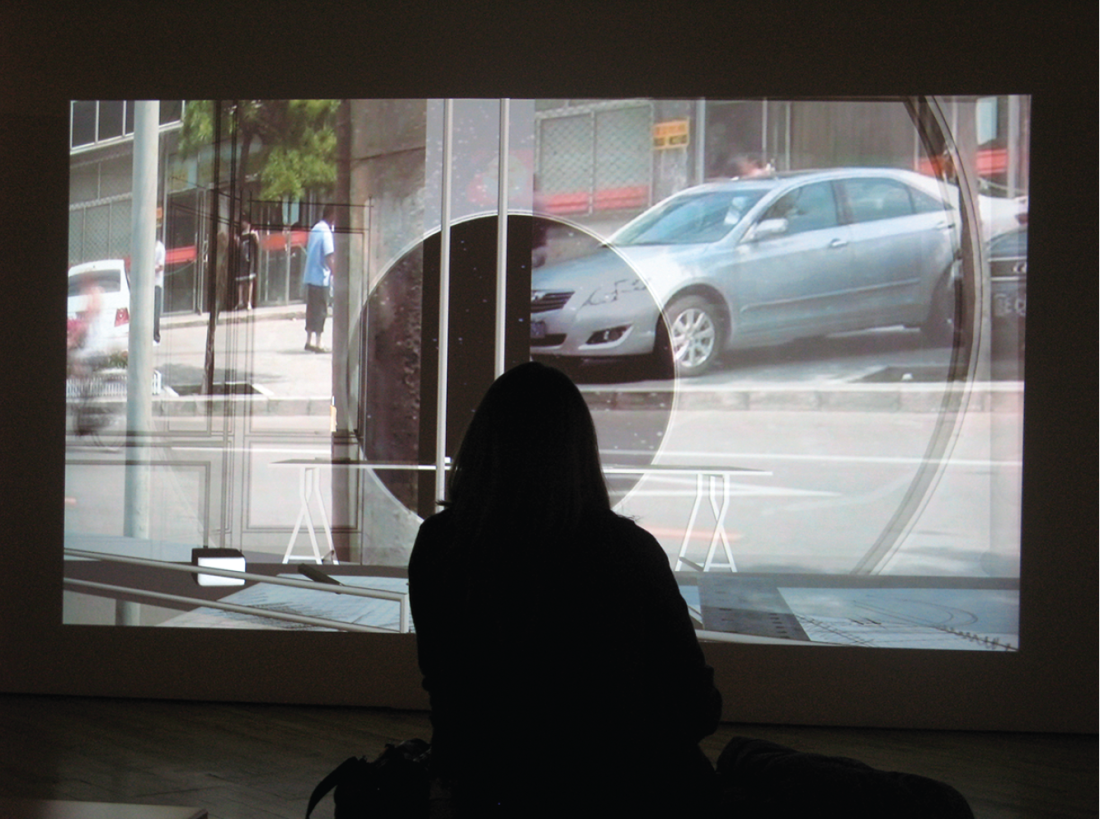Yam Lau
In Yam Lau’s video projection a house builds and unbuilds itself. Its space of visuality also is seen to build and unbuild. This house, this model, a pavilion that Yam Lau’s projection draws, appears always to have been so, an unfolding infinitude. It simply draws and redraws itself in endlessly dissolving moments, in perfect synch with so much of what is around us; when we listen we hear something Bachelardian, a poetic moment. In its rotations, Lau’s house is built with walls consisting of evolving and dissolving screens projected directly onto a wall. His imagery is largely made of other screens that dissolve into one another. These are layers that multiply endlessly, the screen being in this way simultaneously a medium and content, interchangeably transparent and translucent. The windows, the framing, the screens, the scaffolding, the doorways and such are all simply layers, each perpetually revealing their implication in the other. A screen is what comes between, a medium, a veil that, in obscuring, may also reveal. For Lau, it includes an aspect of traditional Chinese culture, the screen having widespread significance in both painting and building. On the other hand, the space we are watching suggests an autonomous and non-human time space, an ambiguous, uncanny, machine space such as we saw in 2001: A Space Odyssey.
“Between Past and Present: Lived Moments in Beijing” proposes to bring digital design capabilities into proximity with traditional concerns such as memory, home, building and the question of time’s movement, which is also the question of mortality—the answer to the question of what could be between past and present.
“Projection” is a term carrying a strong sense of temporality, that of planning, imagining, building, imposing and remembering. In Lau’s past works these also typically exist in revolving layers of superimposition. The boundaries of the work become pertinent, this being an illuminated wall drawing, a drawing done with shadows on a wall, a memory space most people carry forward from their early childhood, a contemplation with which to occupy oneself while waiting to fall asleep. In this case, the wall is both screen and built space.

Yam Lau, Between Past and the Present: Lived Moments in Beijing, installation view. Digital video animation, 2012. Courtesy Katzman Kamen Gallery, Toronto
Lau counters the desire for home as permanence, for what is fixed, a secure(d) site. However, the house and home that Lau proposes in this particular housing project doesn’t seem to offer that kind of stability and protection at all, being drawn and redrawn perpetually, favouring a finally “full/void.”
Surrounding Lau’s house there are scenes of reverie, quiet waters lap at the edges of this house that floats like an island and that at other times seems to be drifting through a starry night complete with sickle moon. Of course, in this case we can’t miss recognizing the faux treatments that protect us from falling too far into one or another moment. The stars are clumsily out of focus; the waves on this water are softened with devices adopted from the tools of this relatively simple deployment of CAD technology.
These images of contemporary street life in China collaged into the grids of ever changing webs may be memories from a Beijing childhood, displaced in time. We depart from the realm of an idealized China when the present moment of today’s busy street life bursts in with all the noise one would associate with life in a modern industrial giant. Lau inserts actual scenes into the CAD drawings, marking the claim to a “now” in the ideal space of the projection. As screens within screens, transparency within opacity, inside within outside, Lau’s building erases as it goes, neither process gaining on the other, leaving us in the tranquility of a walled garden, somewhere.
Unlike conventional film viewing, Lau attempts to give us not a static object but the dynamic activity of viewing. His focus is on our role as viewing subjects. Although there is apparently complex technology in his installations, Lau’s video undermines any display of technological power, his video often displaying its own internal limitations, such as, for example, the strobing shadows that mark the limit of the computer’s capacity to render movement, or the misalignments that occur in various overlappings. The tools of digital imaging are made discreetly visible inside this imaging field while the work reveals itself as a revealing of its own processes of construction. Where Lau leaves us, in this space between past and present, is in a place of ambiguity, a place of the serious tension that arises between our human and our technological being. Lau’s project seems to make this a place where the challenge is posed and made liveable by way of our relationship with the past, a futural home in time, time as the place of dwelling. ❚
“Between Past and Present: Lived Moments in Beijing” was exhibited at Katzman Kamen Gallery, Toronto, from November 24 to December 22, 2012.
Stephen Horne lives in Montreal and France.

